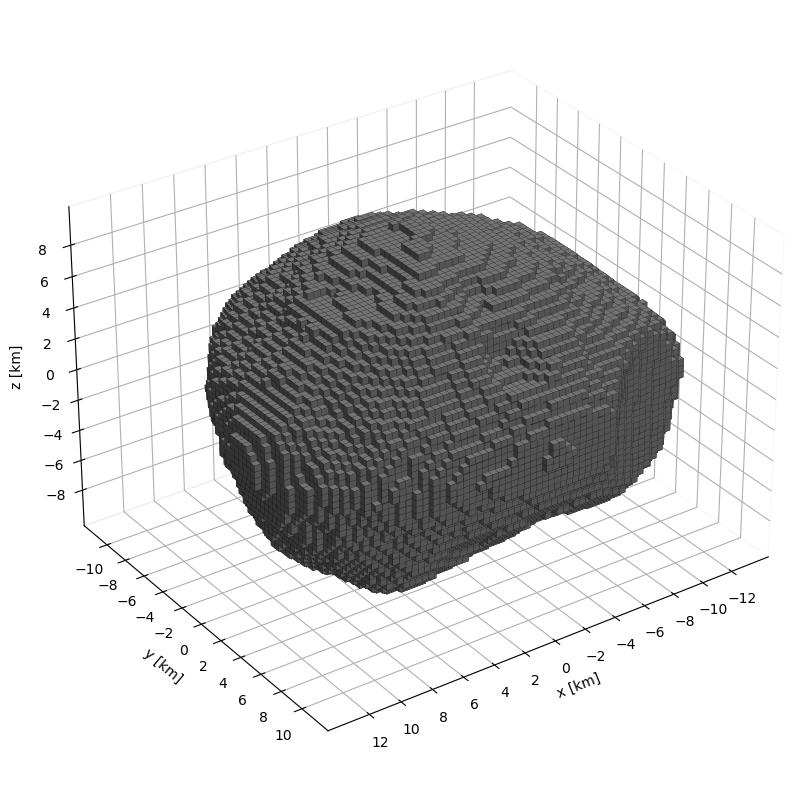Comparison of Phobos Geophysical Properties for different Shape Models using Voxel Mascons
- Institute of Space Technology & Space Applications, Universität der Bundeswehr München, Neubiberg, Germany
Abstract
Several space missions like Mars Global Surveyor, Mars Express and Phobos 2 have already visited the Martian moon Phobos and performed measurements regarding its geophysical properties. Those have shown that it has a low average density (1861±11)kgm-3 [1], indicating a high proportion of porosity. Comparison with other objects is a challenging task, as it is not entirely clear whether Phobos is a C-type or D-type asteroid. Phobos has a highly irregular shape, resembling a heavily cratered asteroid. The limited information about its inner mass distribution makes it an interesting object for future research. By determining the gravity field through precise orbit determination around the body, it is possible to draw assumptions on the body’s mass distribution. Information on the interior properties can then be used to make conclusions about Phobos formation and evolution. However, to investigate Phobos inner structure, some challenges must be overcome. First, a precise conversion to discrete elements of the body’s shape is mandatory due to its contribution on the gravitational field. Secondly, a suitable simulation environment is necessary, which can compute the geophysical properties efficiently with high precision.
This study compares two shape models of Phobos, Ernst et. al [1] and Willner et. al [2] using a voxel-based mass-concentration method [3], to discretize each shape model for different cube resolution and reconstruction algorithms. We investigate the influence of the shape model, the cube edge length and the choice of the reconstruction algorithm for the following geophysical quantities, assuming a homogeneous mass distribution:
- Gravity Coefficients Cnm, Snm
- Near-Surface Acceleration
- Principle Moments of Inertia Ixx, Iyy, Izz
- Libration Amplitude Θ
We are able to compute the Gravity Coefficients up to an arbitrary order, but focus our analysis on C20 and C22, since current measurements are only available for values up to order two.
Preliminary results for the volume reconstruction are shown in the following. Figure 1 shows a discretization of Ernst’s shape model using voxels with an edge length of 400m and a pointcloud algorithm for reconstruction. It can be observed that the shape and various characteristics, such as larger craters and especially the Stickney crater, are well represented.

Figure 1: Voxel reconstruction of Phobos using the Ernst model.
Figure 2 illustrates the reconstructed volume of Phobos for the Ernst model using different voxel edge lengths and reconstruction algorithms. The green lines denote upper and lower boundaries of Phobos volume, while red and blue dots correspond to the used reconstruction algorithm. The voxel representations demonstrate consistency with the measurement data, accounting for uncertainties and numerical errors. Results regarding the other parameters will be discussed in this study.
Figure 2: Volume of the voxel approximation of Phobos using the Ernst model.
References
[1] ERNST, Carolyn M., et al. High-resolution shape models of Phobos and Deimos from stereophotoclinometry. Earth, Planets and Space, 2023, 75. Jg., Nr. 1, S. 103
[2] WILLNER, Konrad; SHI, Xian; OBERST, Juergen. Phobos' shape and topography models. Planetary and Space Science, 2014, 102. Jg., S. 51-59.
[3] HASER, B., et al. Voxel-based Density Models for accurate gravitational Field Computation, EGU24
How to cite: Haser, B. and Andert, T.: Comparison of Phobos Geophysical Properties for different Shape Models using Voxel Mascons, Europlanet Science Congress 2024, Berlin, Germany, 8–13 Sep 2024, EPSC2024-507, https://doi.org/10.5194/epsc2024-507, 2024.